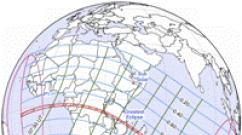List of flightless birds of the planet. Large and small, extinct and existing
There are many types of birds - large and small, flying and flightless. And once upon a time, very strange and unusual birds lived on Earth. In this post we will talk about the largest of the birds.
The largest living bird in the world is, of course, African ostrich. The average height of an ostrich is 270 cm, and its weight is about 115 kg. But some representatives may be taller than 3 m and weigh more than 150 kg.
Ostrich
The ostrich is a flightless bird with small, short wings that it sometimes flaps to keep its balance while running. But an ostrich can run very fast - at a speed of about 70 km / h, and in a short section it can accelerate up to 90 km / h.
There are many interesting facts about ostriches.
Unlike most birds, the ostrich has only two toes on its feet. With its foot, an ostrich can inflict a very strong blow, dangerous for a person or for a large predator.
Ostriches feed mainly on plant foods, but they can also prey on insects, small rodents and lizards. For better digestion of food, the ostrich swallows stones, and can do without water for quite some time.
Ostriches have long been bred in captivity on special farms for eggs, meat and feathers. For example, one ostrich egg can replace 25 chicken eggs. At the same time, some farmers successfully breed ostriches in Siberia, despite the fact that there are very severe frosts. It would seem, how can an animal from Africa endure Siberian frosts? But it turns out that earlier ostriches lived not only in Africa, but also in Asia, the remains of wild ostriches were found in Transbaikalia.
An ostrich may well carry a person on itself, riding ostriches is one of the entertainments offered to tourists in Vietnam and other countries.

In the US, they even hold ostrich races.
What is the largest flying bird in the world? Here you can encounter different answers, and all because there are many large flying birds, their average size and weight are close to each other, and among which species the largest individual individuals are found is not so easy to determine.
Most often, the largest flying bird is called African bustard. Large individuals can reach 20 kg. Of course, bustards are mostly ground birds, but they still know how to fly.

african bustard

African bustard can fly
And here are other large flying birds.
The largest flying bird with the largest wingspan wandering albatross. This bird weighs up to 13 kg, and its wingspan can exceed 3.5 m. Albatrosses are perfectly adapted for flight; in search of prey, they easily overcome thousands of kilometers over the open sea.

wandering albatross
The largest flying birds of prey are vultures and condors. They reach a weight of 14-15 kg, and their wingspan reaches 3 m. These birds prefer mountainous terrain. black vulture lives in Eurasia and Africa, including in Russia, and andean condor- In South America.

black vulture

andean condor
What about extinct birds? It turns out that quite recently, only some 200-300 years ago, truly giant birds lived on Earth. Huge birds living in New Zealand Moa reached a height of 3.6 m and weighed up to 250 kg.

Moa (reconstruction)
And in Madagascar, even larger birds lived - Epiornis, reaching 5 m in height and weighing 500 kg. Epiornis egg (they can still be found in Madagascar) is about 7 times heavier than an ostrich.

Epiornis
Unfortunately, these huge birds became extinct due to hunting for them.
Finally, the largest flying bird that ever lived on Earth is considered giant teratorn, or argentavis, the remains of which were found in Argentina. Perhaps this bird, which lived about 6-8 million years ago, was the ancestor of modern condors, but compared to them it was much larger. The wingspan of this bird reached 7 m, and weight - 70-80 kg.

Giant teratorn (argentavis)
And the titans; they were distributed about 65 million years ago and belonged to a group of birds, which is informally called "terrible birds". Archaeological excavations have shown that the birds were extremely large and had the ability to chase their prey. Modern species of birds are not comparable with their ancestors, but among them there are also very large representatives.
The ostrich is the largest living bird
The ostrich is the largest living bird that can reach a height of up to 2.7 m and weigh up to 157 kg. This flightless bird is known to be able to reach speeds of up to 70 km/h. The female ostrich lays the largest eggs of any living bird. They are native to Africa, where they are found in large numbers. Ostriches also live in parts of Asia.
Fan-bearing crowned pigeon - the largest pigeon

The Victorian pigeon is the largest bird on the planet in the pigeon family. They are easily distinguished by the lacy feathers on their heads, resembling a crown. They are considered very beautiful pigeons, with a blue-gray color, and can reach a body length of up to 75 cm and weigh up to 2.5 kg. The Victorian pigeon is native to New Guinea, and was named after Queen Victoria.
The trumpeter swan is the largest waterfowl

The trumpeter swan is the largest waterfowl in the world, a representative of the duck family. It is endemic to the North American and is considered the heaviest bird found on this one. Their wingspan is about 2.1 m, body length is 1.5-1.8 m, and weight can reach more than 12 kg. In 1933, the birds were considered almost extinct in North America, with a population of less than 70 individuals, but over time, aerial photography along the coast of Alaska showed a large flock of these birds, and some of them were subsequently reintroduced to other parts of the continent. In 2010, there were over 46,000 birds of this species in the wild.
The black vulture is the largest bird of prey

The black vulture is the largest and one of the heaviest birds of prey on Earth. The bird is known to reach a body length of about 1 m and can weigh up to 12 kg, with a wingspan of almost 3 m. This species is found in Europe, Africa and Asia.
Galapagos flightless cormorant - the largest cormorant

The Galapagos flightless cormorant is the largest and heaviest bird in the cormorant family. It is endemic to the Galapagos Islands and is the only flightless bird in its family. However, the flightless cormorant is known to be a fantastic swimmer, and large flocks of these birds can be seen along the coast of Fernandina and Isabela Islands.
The Philippine Eagle is the largest living eagle.

The Philippine Eagle is the largest eagle and one of the largest birds of prey in the world. It was once called the monkey-eater eagle because the indigenous people of the Philippines claim that these birds used to prey on monkeys. The eagle can reach a length of up to 1 m and weigh up to 8 kg, while the wingspan is up to 2.2 m. The bird is common in the tropical forests of the Philippine Islands. The species is currently on the verge of extinction.
The red-billed phaeton is the largest tropical bird

The red-billed phaeton is the largest tropical bird. It is distributed in the tropical Atlantic, along the coast of the Indian Ocean and in the eastern Pacific. These birds can fly at a height of 30 m above the sea, at a speed of 44 km/h. There are three subspecies of the red-billed phaeton: P.a. aethereus, P. a. mesonauta, P. a. indicus.
Pink flamingo - the biggest flamingo

The pink flamingo is the largest and most common bird in the flamingo family. It lives in southern Europe, the Indian subcontinent and Africa. These birds can weigh up to 4 kg and have a total body length of up to 1.3 m. Pink flamingos prefer warm areas and muddy lakes where they feed and breed.
The Hyacinth Macaw is the largest parrot in terms of body length.

The Hyacinth Macaw is the largest and arguably the most stunning parrot species in the world. It is endemic to Brazil, Bolivia and Paraguay. Birds can reach a body length of about 1 m and weigh up to 1.7 kg. Birds have blue feathers, but in some cases the neck feathers are slightly greyish. Their habitats have been destroyed and a large number of hyacinth macaws are kept as pets and are therefore classified as a vulnerable species according to the IUCN.
The black cockatoo is the largest cockatoo

The black cockatoo is the largest member of the cockatoo family. It is distributed on Aru Island, Cape York Peninsula and New Guinea. It has red cheeks and a large black beak. As you know, the black cockatoo reaches a body length of about 80 cm and can weigh up to 1 kg.
The emperor penguin is the largest penguin
The emperor penguin is the heaviest and largest penguin species on the planet. These flightless birds inhabit the Antarctic. They can reach a height of over 1.2 m and weigh up to 45 kg. Penguins have physiological adaptations to withstand harsh environmental temperatures and form colonies of up to 10,000 individuals. In these colonies, penguins closely approach each other, and the temperature inside them can exceed +35°C, while the ambient temperature is below -20°C.
Fish owl - the largest owl

Fish owl - the largest owl in the world, which is on the verge of extinction. Found in Russia, China and Korea. Females are larger than males and can grow up to 72 cm in length, weigh up to 4.6 kg, and have a wingspan of up to 1.9 m. They are known to be very fast and strong hunters.
Gyrfalcon - the largest falcon

Gyrfalcon is the largest falcon on earth. It is known that it is common in the arctic and subarctic climatic zones of Europe, Asia and North America. It pursues its prey at great speed and often exhausts it, then uses its claws to capture it. Females are larger than males and can grow up to 65 cm in length, weigh more than 2 kg, and also have a wingspan of more than 1.5 m.
If you find an error, please highlight a piece of text and click Ctrl+Enter.
Birds are unique and funny creations of nature. They are beautiful, colorful, weightless. However, there are also some large and giant birds that will amaze you with their size and structure. Over 90% of birds are small and fly light and fast, but the remaining 10% are incredibly large. This includes both flying and non-flying bird species. Here are the ten largest birds in the world.
10 Wandering Albatross

A rather large bird that reaches a length of up to 117 cm. This bird is native to the northern part of the Pacific and Southern oceans. In total, there are about 24 different species of albatrosses in the world, of which the wandering albatross is the largest. It weighs up to 12 kg and feeds on squid and fish. He also drinks large amounts of salt water. Most of its time, this giant glides through the ocean winds and floats on the surface of the water. Thus, it is difficult to meet on land. During the breeding season, these albatrosses form colonies on various outlying islands.
9. Mute Swan

This aquatic bird easily grows up to 180 cm and usually weighs 8 to 13 kg (individuals can weigh up to 22.5 kg), therefore it is one of the ten largest birds in the world. The mute swan is very beautiful, delicate and has a long neck. It helps birds find food under the surface of the water, as these swans mainly feed on insects, aquatic vegetation, as well as small fish. Their wingspan is up to 240 cm. These birds are a bit aggressive, but very smart. They remember well the people who take care of them, or feed them.
8 Curly Pelican
Native to South Asia and Europe, the Dalmatian Pelican is considered one of the most ancient, as well as heavy flying birds on earth. It grows up to 180 cm long and weighs about 14 kg. Also, this pelican has a huge wingspan that reaches 3.4 m. In terms of their appearance, they have similar data with large white pelicans. However, they are comparatively larger than their relatives. The curly pelican has the second largest beak in the world, its length is up to 50 cm. These birds feed mainly on fish and other marine life. They can easily consume about 2 kg of fish per day. Very fond of eel, carp, catfish, as well as perch.
7 Andean Condor

This member of the vulture family is ranked seventh in the ten largest birds in the world. The large wings of the Andean condor help it fly by balancing its body weight. Wingspan up to 3 meters, weight - up to 15 kg, body length - 1.2 meters or more. Just like other vultures, these condors feed on carrion as well as domestic animals. They feast on dead fish and dead seals along the coastline. They hunt for eggs in the nests of other birds. Today it has the status of an endangered species. Can live up to 75 years.
6 African Great Bustard

The African great bustard is very huge, its weight reaches 18-20 kg. Their huge size does not prevent them from flying, which is why these birds are considered the largest flying birds in the world. These giants eat snakes, insects, seeds, berries as well as lizards as their main diet. The African great bustard spends most of its time on the ground looking for food.
5. Large, or northern rhea

A large flightless bird that is endemic to South America and reaches a length of 140 cm. A large rhea weighs up to 27 kg. The bird has very large wings, which it uses to balance the body while moving, as well as to change direction while running. They feed on various insects, small birds, and lizards. Large nandu have long and powerful legs, which they use as a defense. During the mating season, the male mates with several females, and all the eggs are laid in one place. Thus, you can find more than 50 eggs in one nest. The average lifespan of this bird is 10 years.
4 Emperor Penguin

Natives of Antarctica weigh about 45 kg and are therefore also among the ten largest birds in the world. These penguins have the ability to travel up to 80 km in search of food. It is also interesting that they can dive to a depth of 450 m. Their main diet includes squid, krill, as well as fish. Males show a lot of attention to females during mating, and also take care of the eggs. The average lifespan of an emperor penguin in the wild is up to 20 years. However, if conditions are ideal, then a penguin can live up to 50 years. The front of the emperor penguin's body is covered with a waterproof feather.
3. Emu

Emu is a flightless bird native to Australia that weighs up to 60 kg. Emu has a length of 150-190 cm and is mainly considered a resident of woodlands, savannahs and other wooded areas. The main diet of these birds consists of seeds, fruits, plants, lizards, and some insects. These birds may also swallow pebbles. They have very long legs, and this is the reason why these birds can reach speeds of up to 50 km / h while running. The breeding season falls in the winter. An emu egg weighs up to 500 g and is dark green in color.
2. Helmeted, or southern cassowary

The ten largest birds in the world are represented by the southern cassowary, which is considered the second largest bird in the world. It can be seen in the rainforests of Australia and Indonesia. This is a wingless bird that reaches a height of up to 1.5 m and weighs up to 80 kg. The legs of cassowaries are very powerful and thick, which makes it possible for the bird to run at a speed of 48 km / h. The main diet of these birds consists of grass, insects, and mushrooms. The female southern cassowary lays her eggs during the summer season.
1.Ostrich

The ostrich holds first place in the ten largest birds in the world. At the same time, the ostrich is also the heaviest bird. An adult representative easily reaches a weight of 150 kg and has a height of up to 270 cm. The ostrich is also the fastest bird, its maximum running speed is 70 km / h. Native to Africa, today ostriches are mainly found in regions of Australia, feeding on fruits, flowers, seeds, shrubs, and small insects. Another interesting feature of these birds is that they can live without water for several days. They have long and strong legs that help them defend themselves from enemies. Ostriches mostly live in a group containing 10 to 50 birds. .
If you find an error, please highlight a piece of text and click Ctrl+Enter.
Surely, as a child, you also read fairy tales of 1000 and 1 nights. Fantasies of Scheherazade would be the envy of the workshop of Hollywood screenwriters. Every night she told a new story and never repeated herself. Most likely, you did not remember all the stories, but one certainly should have stuck in your memory - the story of Sinbad the Sailor. There were many interesting details in it, but the most memorable are the giant Roc birds, which used elephants to feed their chicks.
Unfortunately (or fortunately), such "birds" are found only in the fairy tales of Scheherazade. Today there are no feathered creatures capable of lifting even a baby elephant. And even the largest bird in the world has a much more modest size. Of course, if we compare it with the legendary Rukh, or even better, the Hindu deity Garuda, capable of carrying the entire Earth on one wing. But still, who can be called the king of the sky today?
Owl - silent killer
Legends attribute many bad properties to this bird: to see - unfortunately, and to hear - and at all to big trouble. And since his voice is loud, he promised trouble to many at once.
Are you starting to believe in omens?
But, despite this, the eagle owl is a charming bird, with an expressive “face” and funny ears. But its dimensions are quite impressive - the wingspan of individual representatives can reach 2 meters. True, the weight in it is dumb, most of the volume is occupied by feathers. But if you see how at night it flies noiselessly against the sky, you can really believe in signs. True, he promises misfortune only to any small living creatures: rodents, bats, hares.
Another thing is interesting: the eagle owl is a great example of adaptation. He can live both in dense forests and on the border of the Arctic Circle. He just does not like one thing - the proximity of human habitation and the territories developed by him. Therefore, in recent years, the habitat of these amazing birds is rapidly shrinking.
Condor - the soul of the Andes
If you are wondering what is the largest flying bird, then here is the answer - the Andean condor. The wingspan of this giant is up to three meters. The weight is also impressive for a flying bird - about 12 kilograms.
Unfortunately, close up, the birds do not look very attractive: with bare heads in clutches of skin, males have a massive crest on their heads. But when this large bird soars at a height of hundreds of meters, spreading its jet-black wings and only slightly moving the ends of its flight feathers ... Such a sight is impossible to forget.
Local farmers disliked and exterminated condors, accusing them of stealing livestock. With ornithology, they apparently had a very bad time. Firstly, these majestic birds are scavengers, and even a tasty goat is indifferent to them. Secondly, they cannot carry anything away due to the special structure of their paws, which are not capable of capturing and holding prey.
But the farmers had no problems with accuracy, and by their joint efforts the condors were brought to the brink of extinction. But now there are several programs to restore their numbers. For example, ornithologists have turned into kidnappers, stealing eggs from nests. The frustrated females then demolish another to make up for the loss. From a stolen egg, scientists grow young condors in captivity in order to then release them into a free life.
Let's hope that joint efforts will bear fruit, and the real soul of the Andes will not disappear from them forever.
Ostriches are running birds
If we talk about ostriches, then this is the largest bird. She has the largest eyes (from the inhabitants of the land) and eggs.
The weight of an adult male can reach 110 kilograms with growth up to 2.3-2.5. No wonder the ostrich doesn't fly. But he runs perfectly - at speeds up to 100 kilometers per hour. Eggs are also impressive, because their weight can reach one and a half kilograms (what scrambled eggs!). For comparison, the weight of an average chicken egg is 50 grams.

The impressive virtues of ostriches were quickly appreciated by people, and now they are actively raised on farms. Their meat is highly valued - lean, low in cholesterol. There is nothing to say about eggs - the shell is used in applied art, for making souvenirs and interior items. And ostrich down and feathers have been valued for many years. Even the skin goes to any haberdashery. Wasteless bird.
By the way, their relatives are cassowaries, also champions. This is the largest forest bird, which, although it does not fly, runs fast and, in which case, can show a good kick.
But compared to their extinct relatives, both ostriches and cassowaries are small birds. So their distant and, alas, extinct relatives - epionisy reached 5 meters in height. The weight and character were appropriate. By the way, they died out not so long ago, only 4-5 millennia ago, so they could well become the prototype of those very elephant-eating birds.
Argentavis - a small bird
Literally, its name can be translated as "the majestic Argentine bird." And after all, everything is true: he lived on the territory of modern Argentina, and majestic. Just imagine a bird with a wingspan of 8 meters - majestic indeed.
And, unlike his successor, the condor, Argentavi was quite an active predator. We love the maneuver - dive from above swallowing the prey (rather modest in size, but still) entirely.

Indeed majestic
But these creatures left the earth a long time ago. On the one hand, sorry. Surely their flight was a magnificent sight. But on the other hand, I absolutely do not want to get acquainted with a bird of prey the size of a small plane and the powerful beak of an ideal killer.
Smaller sized birds
But in order to slightly move away from such impressive sizes, we can also recall small birds - hummingbirds. This detachment includes several hundred species, which are united by one thing: tiny sizes.
The smallest - the bee hummingbird - weighs a little more than two grams. There are larger species, but all of them are more reminiscent of the size of insects than birds.
The amazing thing about them is the flight. Their wings are very short, but move freely in the shoulder joint, due to which their ends describe a figure-eight in flight. With their help, hummingbirds can hover motionlessly, and also fly not only forward, like normal birds, but also up, down, and backward.
But most of all, people fell in love with them for their sparkling multi-colored feathers. True, they fell in love first of all in the form of jewelry, panels, fans and other cute trinkets. Because of this, even now several species of these crumbs remain in the Red Book.
In general, any bird, even a banal sparrow, is a beautiful and amazing creature. Because they can fly.
The largest birds in the world are striking in their size. But many of them paid for their height and weight, losing the ability to fly. The ranking includes leaders in size, wingspan and weight among flying, non-flying and leading aquatic lifestyles.
The mute swan opens the rating of the largest birds in the world. Among the duck family, this is the largest representative. The weight of the bird can reach 22 kg, wingspan - 2.4 m, height - 1.8 m. Now it is one of the rarest birds in the wild, as hunting for swans has led to their extinction. Mute mute feel good in captivity and therefore are an adornment of many pond ensembles. The swan got its name from the hissing sound it makes when angry.

Birds that cannot fly - penguins are among the heaviest and largest in the world. The most outstanding of the family is the emperor penguin, whose weight reaches 50 kg, height up to 1.3 m. The penguin looks for prey exclusively in the water. He has well-developed eyesight, which allows him to dive to a depth of 550 m. To find food, penguins are ready to travel considerable distances and pick up speed up to 55-58 km / h. Birds nest in colonies. In severe frosts, they gather in large groups to keep warm and constantly move from one place to another - this is how each individual receives its share of heat.

One of the largest and heaviest birds is the Steller's sea eagle. The wingspan of an adult can reach up to 2.45 m, height 1.15 m. This predator prefers to feed on salmon species, but it also poses a serious threat to young seals, which it can also attack. Due to their significant weight (up to 9 kg), sea eagles do not make long flights, so they nest in the vicinity of their prey. Despite the fact that the eagles build pairs for procreation, their betrayal is an ordinary case. They mate with other individuals, both males and females. Therefore, in a family of eagles there may be chicks from different fathers.

The physique of the bustard allows it to be included in the list of the largest birds. Males reach 16 kg, while the body length is 1 m, and the span of wide strong wings can be up to 2.4 m. The bustard flies excellently, although it gains height very slowly. But more she likes to move on the ground, for this she has powerful non-feathered paws. Unlike other birds, bustards do not have a coccygeal gland, which produces a fatty lubricant for plumage. Therefore, during the period of rains and frosts, they become helpless due to wet and frozen wings.

The crane is considered not only the largest bird in the world, but also the most ancient. The formation of the family dates back to the time of the dinosaurs. The Indian representative of the family is considered the largest: height - 1.75 m, wingspan - up to 2.4 m. This height makes the crane the tallest flying bird on the planet. The family also has its own heavyweights - this is the Japanese crane, capable of gaining up to 12 kg. In almost every country where cranes live, they are valued for their beauty, grace, mating dances and fidelity. Birds keep a couple until the end of their lives.

Another largest bird, the curly pelican, so named for the curly feathers on its head, also has a strange name “woman”. The body of the bird reaches a length of 1.8 m, the wingspan is 3.4 m, the length of the beak is 0.5 m (the second largest in the world). Weight can be gained up to 15 kg. On a day, a large bird eats food, the weight of which is 20-30% of the weight of the animal itself. The pelican flies and swims equally well. But in the water, the wings get wet quickly, so he often lifts them up while swimming to let the water flow. Also, the pelican constantly draws its beak along the wings, as if squeezing water, so that in case of danger the plumage is dry, and it can fly freely.

The black vulture or "bearded man" also belongs to the largest birds. The wingspan reaches almost 3 m, and the body length is 1.2 m. Unlike other birds, the male is much larger than the female. Vultures have large eyes, so they have excellent eyesight, and a strong and large beak allows them to tear their prey to pieces. Feathers on the head are replaced by fluff. All these characteristic features are adaptations for the scavenger, who does not hunt, but seeks and eats prey. Vultures eat a lot and even too much. Sometimes, having overfed, they cannot take off under the weight of their own weight. It comes to the point that, sensing danger, vultures regurgitate food in order to rise into the air.

The largest flying bird in the world is the wandering albatross. Its wingspan is 3.3 m and its length is 1.2 m. Among other representatives of the albatross, the wanderer bird has a completely white plumage and only the wing border is trimmed with a black stripe. Albatrosses are solitary, although they nest in colonies. Albatrosses feed on all fish, without exception, that can fit in a huge beak. They are frequent companions of offshore seafood processing trailers, waiting for waste. Albatrosses live for a long time, averaging 30 years, but can live up to 50, and they pair only once.

Cassowaries are one of the largest flightless birds in the world. They are the second largest in the world and the first on the Australian mainland. The helmeted cassowary from the family is the largest representative: height - 1.5 m, weight - 80 kg. The bird runs fast. It is capable of reaching speeds of up to 50 km / h in a matter of seconds and swims well and nimbly. Cassowaries are considered very dangerous. Their main weapon is a dagger-like claw, the length of which reaches 15 cm. In 2004, members of the family were included in the Guinness book as the most dangerous on the planet. They were no longer kept in zoos, as too many injuries were inflicted on employees and visitors.

By right, the ostrich is recognized as the largest bird in the world. But besides this, it is also the heaviest and fastest representative of birds. Its height reaches 2.7 m, weight reaches 200 kg, while the speed that the animal can develop is 70 km / h. No wonder its name means "camel sparrow" in translation. Only one step taken by a bird is 4 meters. How much an ostrich eats in nature is not known for sure, but in captivity it needs 3.5 - 4 kg of food per day. Having no teeth, he eats pebbles for better digestion, he can even swallow metal elements. The largest bird is very dangerous. With a blow of her powerful leg with a long claw, she is able to kill a large predator, even as dangerous as a lion.













